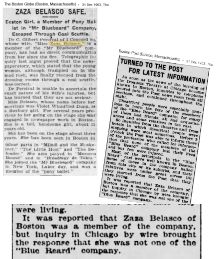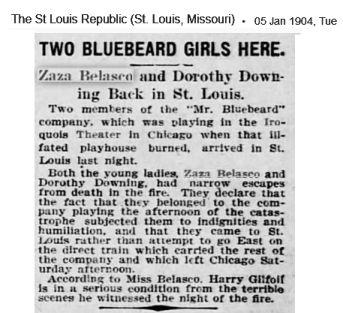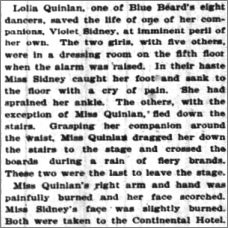|
Was she at the Iroquois Theater?
Probably not.
Zaza Belasco was the stage name of a twenty-one-year-old
red-headed chorus girl born as Winifred "Violet"
Dunne Percival (b. 1882–?).▼1 During America's
worst theater fire on December 30, 1903 in Chicago she
claimed to have
escaped from the Iroquois Theater basement through a manhole
cover. Some chorus girls did so and the story was
widely covered in newspapers. Was Zaza one of
them? Maybe. The problem
with Zaza is that she and her husband used
"alternate facts" when promoting Zaza in stories
issued to newspapers.
One exaggerated newspaper report, in a press release
issued by Zaza's ex-husband, said she was terribly
grieved by the death of the children at the Iroquois
because she knew many of them. None of the
children in the Mr. Bluebeard cast died, and
Violet had grown up in Boston; it's unlikely she came
to know any, least of all "many,"
non-theatrical child victims of the fire during her
three weeks in Chicago.
Soon after the Iroquois fire, a press release
appeared in newspapers around the country about
Zaza's terrifying escape. The story described her as
a member of the
Pony Ballet. I did find one photo of Zaza
wearing a Pony hat, but she was not listed as a cast
member. The Pony Ballet act appeared for several
years with many cast members, so Zaza could have
appeared with them in another production or another
city.
Her ruse seemed exposed when the Boston Post
newspaper — for whom she'd written a column
two years before — published that according to
someone in Chicago, there wasn't a Zaza Belasco in
the Mr. Bluebeard company. If she used a
different alias in Chicago, such as Violet Sidney
(see blurb at right), the response to the
Post's inquiry about Zaza Belasco is understandable.
I might be quicker to attribute it to communication
chaos in Chicago if I'd found any of her names in
connection with Mr. Bluebeard
in a Chicago newspaper before the fire. Or if
the most prominent post-fire story that mentioned
Zaza hadn't been a puff piece written by her
ex-husband, riding on the backs of nearly six hundred
victims, e.g., read clipping on the left below.

Zaza-released news story on left, legit story on
right.
Enlarge
Zaza's story was picked up and appeared in many newspapers,
including the Post. Interesting that the
Post, who had worked with her when she was trying to start
a journalism career, specifically called out that
she wasn't in Bluebeard.
Violet
Sidney (1883–1917)
Violet Sidney, a native of England, was the stage
name of Violet Hardy Fairbrother. Her name did not appear before the Iroquois
Theater or in conjunction with the Bluebeard
production. A dancer by that name popped up in
1912 in Chicago in A Night in Spain ballet
produced by Madame Alice Phasey. Violet died
of heart failure in February 1917. She was formerly
associated with Dillingham Productions and was
co-owner of the Athletic Dancing School and reported
as thirty-years old at the time. That means
she would have been born in 1887 and sixteen at the time of the Iroquois Theater
fire. The 1910 US Census, however, reports her
year of birth as 1883, which would have made her
twenty in Mr. Bluebeard. At death she was
married to actor, Alfred Fairbrother, and
had a seven-year-old son.
St. Louis sounded promising

Once questioned and released by authorities, most
Bluebeard performers took a train back to New York
City. Klaw & Erlanger had
been shamed into paying for their
transportation. A story (below) in a St. Louis
newspaper informs that Zaza and her friend, another
chorus girl named Dorothy Downing,▼2
instead chose to go to St. Louis.
K&E probably never offered the pair seats on the
train to NYC because they hadn't come from there to
begin with, had probably come to Chicago to work the
1903-4 season. The reporter in St. Louis
either didn't know that or went along with the
gambit for an easy paragraph story. The St.
Louis World's Fair was due to open in four months
and there'd be plenty of jobs for pretty young
dancers. The referenced indignities and
humilities were that their clothing was destroyed or
retained as evidence for a time and, with all the
theaters in Chicago closed by mayoral edict, they
couldn't find work.
|
 |
|
"All hats should be ventilated. If we went bareheaded, there
would be very little baldness."
Dr. Charles Gilbert Percival.
Journalist con man?
Violet's ex-husband, Dr. "Doc" Charles Percival (1872–1940),
a Massachusetts native, was an interesting character. He had little to do
with the Iroquois other than to cloud its history in small ways.▼3
In 1898, Charles G. Percival's marriage to a different Violet, Clover Sibley,
nicknamed Violet, ended when he learned she was romantically involved with two of
his fellow bicycle racers.
Harvard and
the
Boston Globe?
Nope
He frequently claimed to be a graduate of Harvard's
medical program, and his obituary described him as
the one-time sports editor for the Boston Globe.
He did attend Harvard in 1900 and 1901, and in later
years was listed as an alumnus, but was not listed as a graduate of the medical
program. As to the Boston Globe, he was the cycling editor at the
Boston Daily Journal, a newspaper unrelated to the
Globe.
Lack of a
medical degree didn't prevent his
becoming a pseudo health expert
In the early 1900s, he transitioned
from bicycles to health, writing articles for pseudo-medical
magazines, including Bernarr Macfadden's Physical
Culture, John Harvey Kelloggs Modern Medicine,
and William Benham Snow's The Journal of Advanced
Therapeutics. He wrote about hair and dental care and
homeopathic treatments. For gonorrhea, he
recommended frequent rectum injections of hot water, sitz baths, and complete abstinence from alcohol.
From medicine to automobiles
In 1908 he became a publicist for the
Cleveland Motor Car Company▼4
and 1910 saw such Percival
journalism gems as: Motor Car Makes More
Red Blood: French Scientists Find that Motoring
Develops Red Corpuscles: Vibration of the Automobile
Stirs Up Sluggish Blood Currents. After
spending 1911 to 1912 traveling the country in an
Abbot-Detroit auto, in 1913 he self-published a
100-page book with 200 of his photos, offered for
$.50 — The Trail of the Bull Dog: A 50,000 Mile
Journey by Motor Car Through the United States,
Canada, Mexico, British Columbia, Alaska, and the
Klondike.
In 1918 he contributed articles to US military
magazines, became a captain in a tank division of
the American Expeditionary Forces in France,
commanding the 149th Kentucky and 151 West Virginia
infantries. Any of that true?
Who knows. I've wasted enough time
on this liar.
|
Zaza's background
According to a 1902 New York Times newspaper story,
Violet was the daughter of a Boston livery stable owner.
Genealogical records make her one of four surviving children born
to Irish immigrants Thomas J. Dunne and Winifred Kelley Dunn.
The stage name Zaza was reportedly thought up by Broadway producer and
director George Lederer (1862–1938) based on a notorious
French play about a promiscuous woman that Claudette Colbert
would make famous in 1939. David Belasco's 1898 version starring
Mrs. Leslie Carter was controversial for its sanitized, more virtuous
heroine, and Lederer thought it a good name for a chorus girl,
but reportedly he recommended it to a chorus girl named Maggie O'Brien,
not Violet or Winifred Dunne.
Violet appeared in a couple plays in New York in 1900 and 1901,
then in 1902 ostensibly wrote three articles for Boston newspapers and
lent her name to a beauty advice column in the Sunday Boston,
all of them
probably written by Charles Percival.
In the years after the fire
Zaza Belasco blew up newspaper headlines in March 1914 when
police were trying to locate her because they thought she'd
hired gangsters to kill a neighbor for killing her dog.
Newspapers dropped the story suddenly without a conclusion.
I failed to learn what became of Zaza / Winifred 'Violet"
Dunne Percival after 1914. Probably renamed herself a few
dozen times. A better-known actress named Violet Dunn
appeared in the 1930s, but she was born twenty-five years after Zaza.
A Winifred Dunn, supposedly twenty-five-years old,
turned up as a scene writer in 1924, claiming a
nine-year career in the industry and an improbable
backstory. Could a forty-two-year-old Zaza
have passed for twenty-five?

|
|
Discrepancies and addendum
1. Dunne was sometimes spelled as Dunn.
2. Dorothy Downing was
supposedly the stage name of Mrs. Emma Henchey Cronyn,
who according to an obviously manufactured series of
stories in 1891, had left a bad marriage to a
Buffalo, NY doctor to go on the stage. Of
course none of that checks out with genealogy
records. As to Mr. Bluebeard or the
Iroquois Theater, there are no other newspaper
references connecting Downing to the production or
disaster other than the one above of her turning up
in St. Louis with Zaza. I think it's as
fictitious as Zaza's presence.
3. I suspect Percival's dishonest freelance newspaper submissions about Zaza were the
tip of the iceberg and that he also manufactured fictitious
stories about Lola Quinlan, Violet Quinlin, and Dorothy Downing.
4. For maybe thirty seconds headed the automotive department at
A. W. Erickson Advertising agency in New York, overseeing the Haynes, Garford,
Packard, and Continental Tire accounts. A. W. Erickson was the foundation of the legendary
McCann-Erickson. (Yup, Peggy, Don, and Joan's shop.) Percival may
have been there when agency founder Alfred Erickson was campaigning to start a
national association of ad agencies.
|
